Maybe it’s the cranes, but I’m thinking of Blade Runner: those vertiginous cityscapes where vast screens present a glittering array of faces, all enticements to desire. It’s no surprise to find that director Ridley Scott cut his filmmaking teeth in advertising. At its best, advertising creates hugely memorable images, but commerce always wants its cut.
So, when I first came across the huge digital screen showing contemporary art at Wilton Park in Dublin, my first thought was: what are they selling? We are so used to everything having a commercial imperative that without one, Living Canvas seems like an outlier. That’s because the screen is solely dedicated to art, and is the first of its kind at this scale in Europe. It is also the second only in the world, the other being at the M+ museum in Hong Kong.
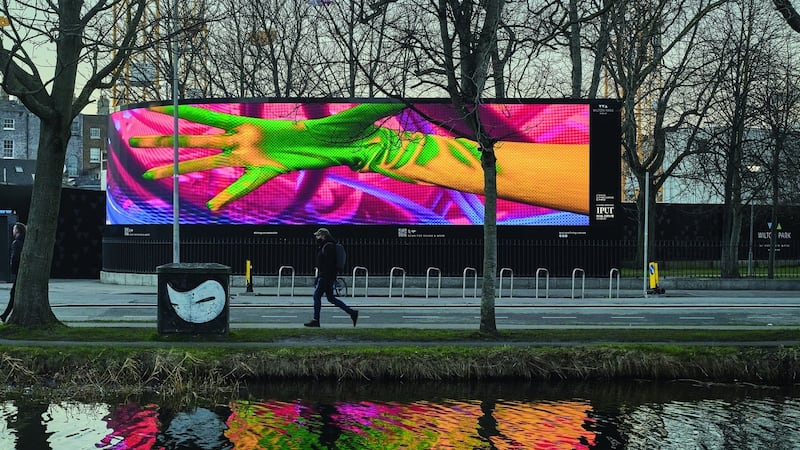
There are, obviously, other huge digital screens out there, and artists have found various ways of getting under the radar of advertising's blandishments. Since 2020, London's famous Piccadilly Lights have been showing art for three minutes each evening, at precisely 8.22pm. The brainchild of Josef O'Connor, and operating as CIRCA (circa.art) across a global network, artists having included Ai Weiwei, Patti Smith and David Hockney. Sometimes glib, sometimes glitzy, and occasionally amazing, the brief art-shots at Piccadilly Circus certainly carry a wow factor.
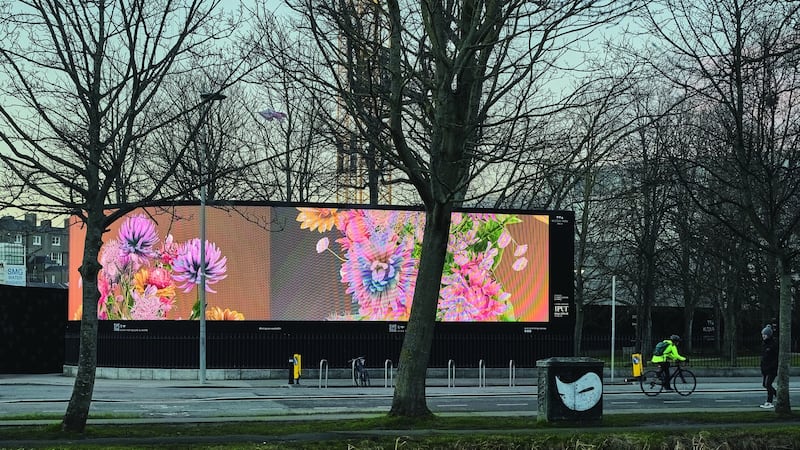
So large outdoor digital screens for art aren't new, but Irish artists do seem to be leading the field. In 2014, I was mesmerised by John Gerrard's Solar Reserve at the Lincoln Center in New York. More recently, Gerrard's Mirror Pavilion popped up at the Galway International Arts Festival in 2020 and 2021, with Mirror Pavilion Corn Work, and Leaf Work respectively. Next week, the Leaf Work will open at the Sydney Biennale of Art.
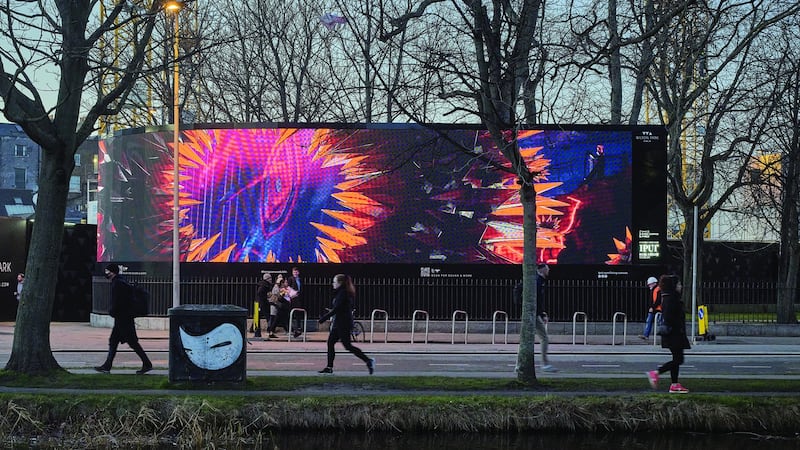
It's the spot where you'll find the Patrick Kavanagh bench. At its heart there is a charming Victorian pocket park
Up to now, Wilton Park might otherwise, have been easily passed by. Currently under re-development on the banks of the Grand Canal, just above Baggot Street Bridge, it’s the spot where you’ll find the Patrick Kavanagh bench. At its heart there is a charming Victorian pocket park, one of those urban oases that city dwellers come to cherish, and the screen itself wraps around the park railings. The redevelopment is courtesy of property company IPUT, which is also responsible for Living Canvas, alongside artists’ studios, which it sponsors in nearby Lad Lane.
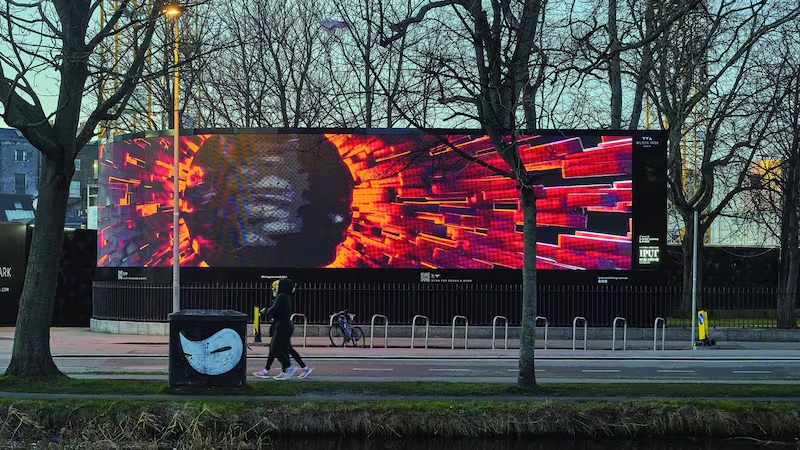
As a consortium of developers are currently opposing the draft Dublin City Development Plan proposal that 5 percent of large-scale developments should be kept for cultural use, this does seem like a move against the commerical grain. However, IPUT chief executive Niall Gaffney takes the view that space for art is vital: “Cities have to make space for art, culture and architecture to thrive, otherwise you won’t have a thriving city.” Full disclosure: when I heard this, I liked the sound of it and was intrigued enough to become involved with the project.
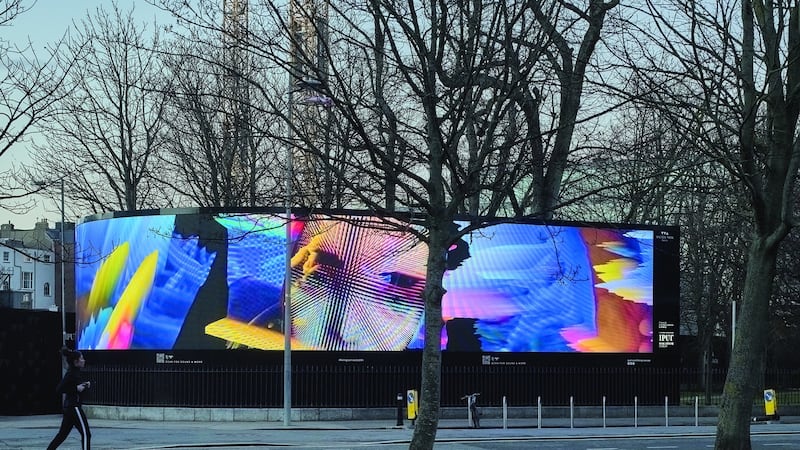
Seen from the inside, it is fascinating. After all, what happens to art when you put it out on the street? What changes in a work you may have already seen in a gallery, now that it is right there, popping up, 25 metres long, on your daily commute? Clearly, you can’t have anything that frightens the horses, or the local wildlife (painstaking work has been done on light levels, so birds and bats can rest easy), but what does that leave you with?
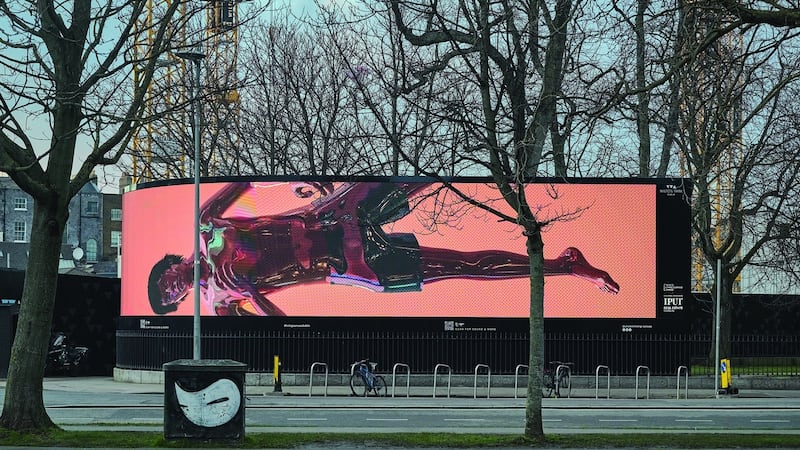
There are differing schools of thought. “Art is about challenging people and giving them new perspectives,” says Aoife Dunne, whose work Brain Chamber premiered on Living Canvas in February. “It’s okay not to like it.”
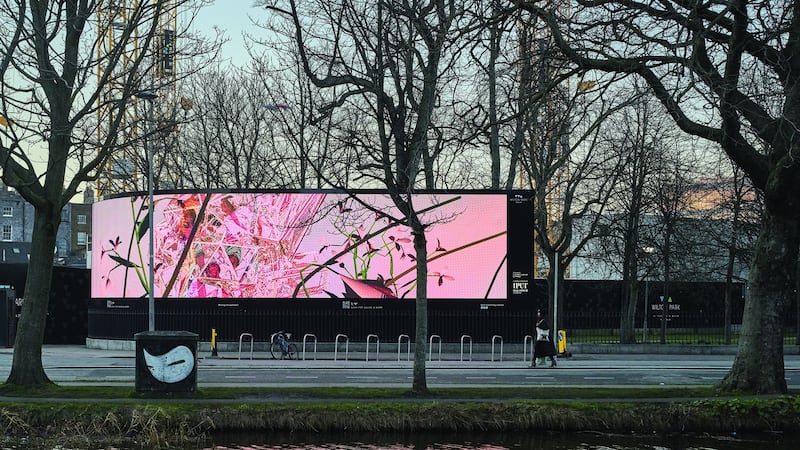
Trapped inside
Brain Chamber presents a new version each day, unfolding over the course of a week, wrapping the sense of being trapped inside a computer or machine around you as you watch. “There’s a fine line between digital art and graphic design,” Dunne says. “It’s tricky to navigate.” Dunne is no stranger to presenting challenging work in public. I first came across her in 2020, when her brilliant Transcending Time toured Fingal during lockdown, showing her work on the panels of a digital advertising van.
Daniel Staines, creative director with Algorithm, the digital design company that built the technical apparatus for the screen, and who created and curated some of the pieces on show this month, has a different view: "The people who come in contact with screens like the Living Canvas don't have a choice in whether they see the screen or not," he says. "So we feel there is a burden of responsibility on the people who programme the screen to make sure that the work is well-considered and adds to the beauty of the area and the experience of being in that space."
This pleasant point of view is at odds with the idea of art as sometimes confrontational, often disconcerting and frequently provocative. Currently the screen is programmed by a panel including Sheena Barrett from Dublin City Council Arts Office, Patrick Murphy of the Royal Hibernian Academy, Simon O'Connor of the Museum of Literature Ireland (MoLI), and Algorithm on the technical side. Aideen Barry, whose Seachmalltacht Oblivion has to do with the coming apocalypse, is fascinated by the idea of the incidental audience, but she doesn't conclude that art in the public realm has to be targeted at harmony.
'Dublin has been suffering this massive cultural erosion,' she says. 'Galleries, studio spaces, performance spaces, they have all been closing because of gentrification'
“Dublin has been suffering this massive cultural erosion,” she says. “Galleries, studio spaces, performance spaces, they have all been closing because of gentrification, so it’s amazing that a real estate company has done something about it. It’s not about distraction,” she continues, even as she describes runners pausing mid run, or cyclists stopping for a look as they pass on the towpath.
Her film has also been on show at the Limerick City Gallery of Art, and so she is well placed to compare. "Maybe it has been more philosophical in Limerick with an art-going audience," she says. "But the online reaction to Living Canvas has been a dream. Suddenly it opens up the possibility of other audiences to enter through different prisms."
Ailbhe Ní Bhriain and Alan Butler also have work on show, and each is alert to the uniqueness of the context. “The city is not exactly short of images,” says Ní Bhriain. “They are everywhere, clamouring, distracting, seducing.”
“It’s not often visual artists, who primarily exhibit in galleries, get to see their work on a screen of this scale, and so publicly,” agrees Butler. “The tech behind it is excellent,” he says. “I decided to produce an app that generates the visuals in real time, just because it was possible. Another aspect which makes this project important is that, for artists who work with video, the project has essentially added a new gallery to the city.”
The size of the screen is also key to the thinking of John Beattie, Bassam Al Sabah and Clare Langan. Beattie describes it as “monumental, immersive, and epic”, while Al Sabah is aware of how it lent his work a grander scale and vividness. Meanwhile, already on a monumental scale, Langan’s River, which shows water shot in extreme close-up and extreme slow motion, becomes hypnotic on the canal banks.
Size matters
So size does matter when it comes to this kind of art. But at what point does scale dissolve into lurid spectacle? Sometimes in a gallery, when confronted by massive artworks, I try to imagine them small, and see if they still work. Often the scale is the point, and with minimalist work, the size is often what allows you (metaphorically speaking) into the work.
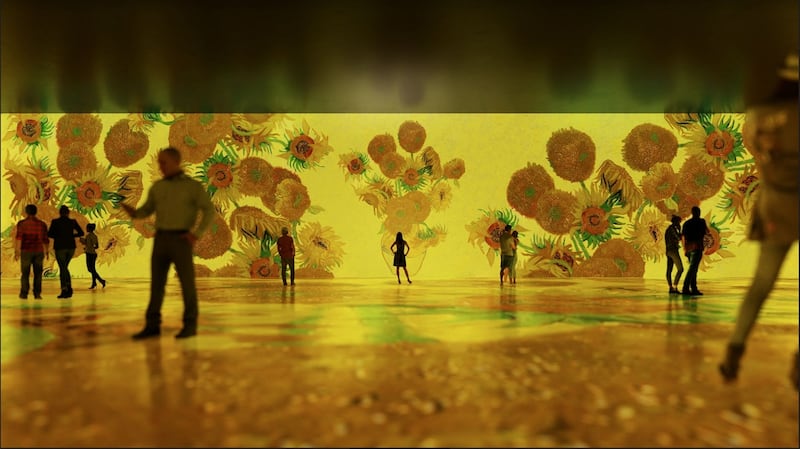
But size can be very beguiling. Take pretty much any photo, blow it up, mount it on perspex and suddenly it looks very much like art. Oddly enough, the opposite can happen too. A couple of years ago, I went to see Van Gogh, Starry Night at Atelier des Lumières in Paris. The artist’s most famous works were projected at epic scale in what amounted to a warehouse space. Navigating all the selfie-takers, I struggled to find a transcendent moment, which felt very odd, as I have often become utterly lost in the same artist’s work, even when jet lagged in busy museums. Take the test yourself when a similar project, Van Gogh Dublin comes to the RDS this May.
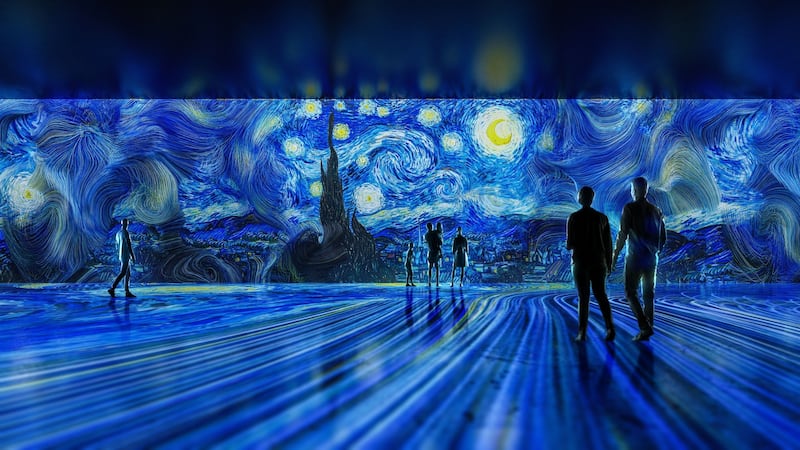
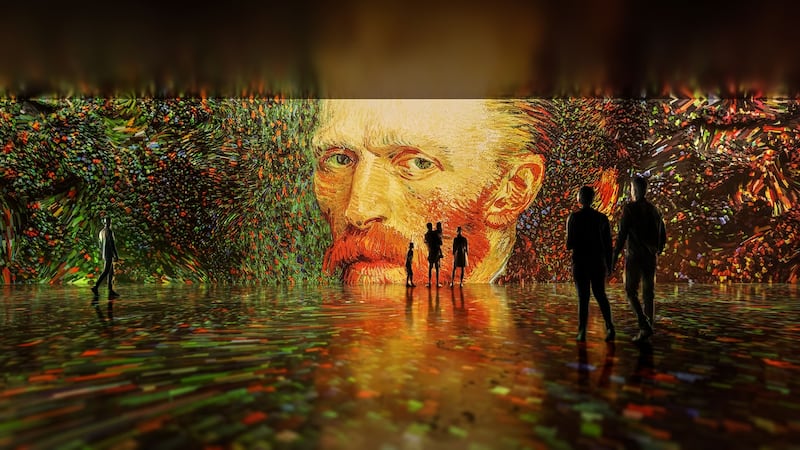
Art as spectacle, or as a pleasing addition to the environment, force for public good, or whatever the artist has decided art is, remains a tricky conundrum, especially when that art is in the public realm. One solution is to leave it up to artists, who are adept at adding layers to what might, in the first instance, seem simple.
Barbara Knezevic’s work, Touch Techne, originally commissioned for Visual Carlow’s Woman in the Machine, is a kaleidoscopic series of footage from stock imagery. But look closer, and you’re actually seeing the forces of the natural world: fire, earth, air, water; animal, vegetable, mineral. Closer still and see how the screen itself is created from rare earth minerals, which, as Knezevic says, “asks for the viewer to consider the materiality of the screen itself, not to ignore it or look through it as we ordinarily would. A strange appearance on a city street.”
Van Gogh Dublin is at the RDS from May 16 to August 4. Tickets €28.14, vangoghdublin.com. Atelier des Lumières is now showing Kandinsky and Cezanne, until January 2023, from €16, atelier-lumieres.com. Aideen Barry's Oblivion opens at the Source Arts Centre, Thurles, on March 19, thesourceartscentre.ie
For more on Living Canvas, see iput.com/living-canvas
Digital Art at Wilton Park
Aoife Dunne's Brain Chamber plays daily from 8am to 10pm on March 5 and 6, with a new version each day. Thereafter, the programme rotates each week between Brain Chamber, and works by Clare Langan, Barbara Knezevic , John Beattie, Alan Butler, Ailbhe Ní Bhriain, Bassam Al-Sabah, Aideen Barry; and Something in the Water, a programme of short pieces inspired by the writers who lived and worked in and around Wilton Park, curated by Louisa Carroll and Algorithm. Upcoming works include projects by Brian Eno, Alan Gilsenan and Chris Haughton. For times and dates seeiput.com/living-canvas.












